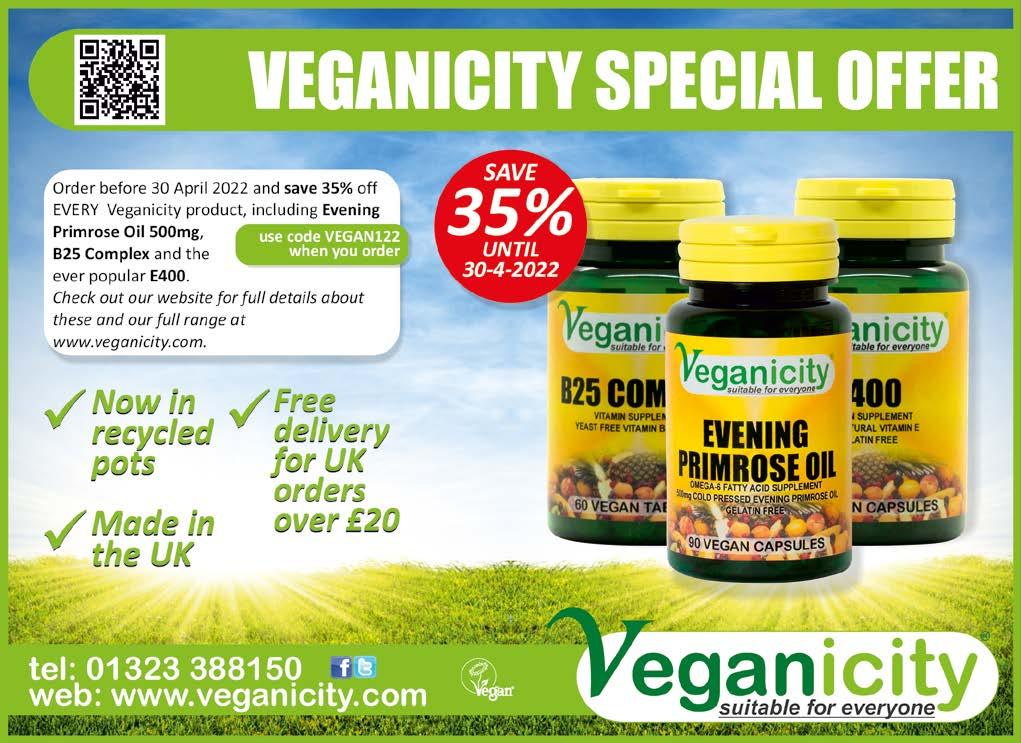
4 minute read
Nutrition
VEGANUARY AND BEYOND
Veganuary is the perfect opportunity to adopt a more compassionate lifestyle, which often begins with dietary changes. For some this is unimaginable due to fear of missing out on their favourite foods. Resistance to change is one of the world’s biggest problems, and although veganism is not just about what’s on our plates, what better way to sway non-vegans than through their stomachs?
Advertisement
Cheese
Vegan cheese often has a bad reputation, failing to meet the taste bud expectations of many dairy cheese fanatics. Do you remember a food you used to hate as a child that you have now grown to love? (Mine was olives.) Our taste preferences do change!
Many vegan cheeses are based on coconut oil and seasonings. Although rich in calcium and protein, it is also full of salt and saturated fat – hardly a recommended dietary staple. This means that nutritionally, cheese doesn’t need to be a key part of your diet. However, someone really missing cheese could try making their own vegan alternative. An artisan style vegan cheese can be made using blended cashew nuts, water and a thickening agent. Add seasoning such as smoked paprika for a smokey variety, chilli peppers for some heat or chives for an oniony flavour. Check out the recipe on the next page for some inspiration.
Tofu
Most people who didn’t grow up eating tofu have no idea what to do with it. The most common tofu found in western diets is silken (ambient) or firm (refrigerated). Silken tofu is soft, perfect for blending with other ingredients for a creamy texture to use in both sweet and savoury dishes. Firm tofu has a spongier texture and absorbs flavours well. It is often packed in a water solution, so it is important to press your tofu before marinating and cooking to avoid diluting its flavour.
Tofu is a fabulous protein-dense alternative to meat, low in saturated fat, rich in calcium (if calcium-set) and so versatile. Why not introduce a tofu braised steak to your non-vegan friends at your next dinner party or serve tofu scramble at your next brunch meet up?
Legumes
Legumes (peas, beans and lentils) are quality sources of protein. For someone unfamiliar, their preparation can feel overwhelming. Time saving ideas include soaking dried varieties overnight, cooking them using a pressure cooker or preparing in large batches and freezing for future meals.
Red split lentils don’t require soaking, and are a rich source of iron, protein and zinc, like many legumes. They are great for thickening sauces, making simple dahl recipes and adding to soups or stews. You can also use tinned varieties of most legumes for convenience – tinned chickpea water (known as aquafaba) can also be as an egg replacer in recipes. It can be stored in ice cube trays to defrost and use when needed, not wasting a single drop.
Sprouting legumes can also be a great way to add them to meals without the bother of cooking. Simple instructions can be found online or included in shop-bought kits.
Take home tips
• Change the narrative by sharing well prepared, delicious vegan meals • Remember – being an effective advocate for veganism can simply be planting a seed
For more information on vegan health and nutrition, including tasty recipes, visit vegansociety.com/nutrition.
Turn over for a delicious recipe to try in Veganuary and beyond.
MOCKARONI CHEESE WITH CAULIFLOWER
serves 4
Macaroni cheese is a classic favourite, and with so many unwilling to commit to the vegan pledge for fear of missing out on cheese, this is the perfect dish to sway them!

Ingredients
300 g macaroni ½ head of cauliflower For the sauce
1 medium carrot, finely chopped 60 g unsalted cashews 1 tbsp rapeseed oil 1 small onion, diced ½ leek, diced 1–2 cloves of garlic 500 ml water 150 ml aquafaba 1 tbsp coconut oil 3 tbsp corn flour 2 tbsp nutritional yeast flakes 1 bunch of chives, finely chopped – leave some aside for garnish Salt and pepper to taste
For the topping
40 g unsalted cashews, crushed 30 g breadcrumbs ½ tbsp nutritional yeast flakes
Directions
Place carrot and 60 g cashews in a pot, cover with water and bring to boil. Cook for 20 minutes until soft.
Heat the rapeseed oil and sauté onions, leeks and garlic in a pan until soft.
Separate cauliflower into florets. Boil macaroni and cauliflower separately, until al dente.
Drain carrots and cashews, reserving water. Add carrots, cashews, aquafaba, corn flour, coconut oil and nutritional yeast flakes to a blender, blend until a smooth creamy texture. Add reserved water as needed, season with salt and pepper.
Combine mixture with the onions, leek, garlic and chives and mix well.
Combine the cauliflower and macaroni and coat with the creamy sauce mixture. Place in a casserole dish.
Combine crushed cashews, breadcrumbs and nutritional yeast flakes and sprinkle over the macaroni and cauliflower mix.
Place in a preheated oven at 180°C for 10–15 minutes until topping has browned.
Sprinkle with remaining chopped chives and serve with a side of your choice, such as rocket and sundried tomatoes.
Recipe provides
kcal 491 fat 16 g sat fat 4.6 g carbohydrates 65 g sugar 8.5 g fibre 8.5 g protein 18 g salt 0.74 g
by Andrea Rymer, Dietitian












